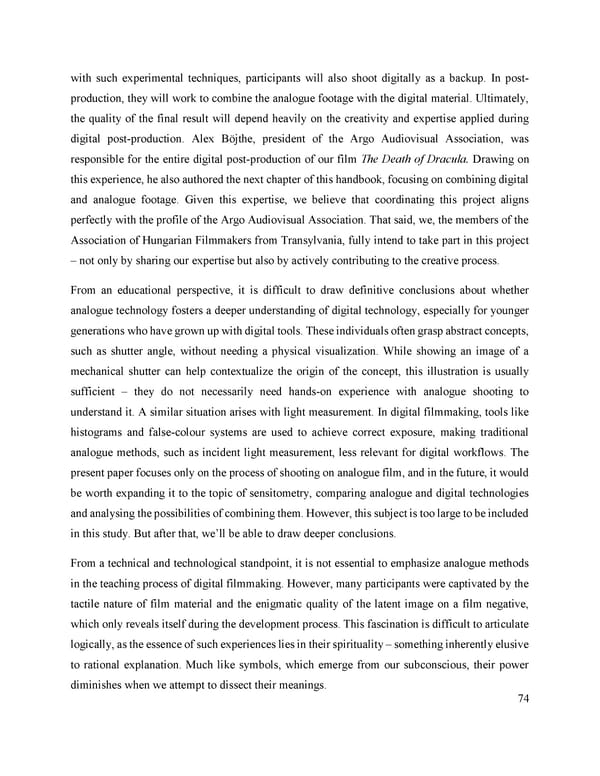with such experimental techniques, participants will also shoot digitally as a backup. In post- production, they will work to combine the analogue footage with the digital material. Ultimately, the quality of the final result will depend heavily on the creativity and expertise applied during digital post-production. Alex Böjthe, president of the Argo Audiovisual Association, was responsible for the entire digital post-production of our film The Death of Dracula. Drawing on this experience, he also authored the next chapter of this handbook, focusing on combining digital and analogue footage. Given this expertise, we believe that coordinating this project aligns perfectly with the profile of the Argo Audiovisual Association. That said, we, the members of the Association of Hungarian Filmmakers from Transylvania, fully intend to take part in this project – not only by sharing our expertise but also by actively contributing to the creative process. From an educational perspective, it is difficult to draw definitive conclusions about whether analogue technology fosters a deeper understanding of digital technology, especially for younger generations who have grown up with digital tools. These individuals often grasp abstract concepts, such as shutter angle, without needing a physical visualization. While showing an image of a mechanical shutter can help contextualize the origin of the concept, this illustration is usually sufficient – they do not necessarily need hands-on experience with analogue shooting to understand it. A similar situation arises with light measurement. In digital filmmaking, tools like histograms and false-colour systems are used to achieve correct exposure, making traditional analogue methods, such as incident light measurement, less relevant for digital workflows. The present paper focuses only on the process of shooting on analogue film, and in the future, it would be worth expanding it to the topic of sensitometry, comparing analogue and digital technologies and analysing the possibilities of combining them. However, this subject is too large to be included in this study. But after that, we’ll be able to draw deeper conclusions. From a technical and technological standpoint, it is not essential to emphasize analogue methods in the teaching process of digital filmmaking. However, many participants were captivated by the tactile nature of film material and the enigmatic quality of the latent image on a film negative, which only reveals itself during the development process. This fascination is difficult to articulate logically, as the essence of such experiences lies in their spirituality – something inherently elusive to rational explanation. Much like symbols, which emerge from our subconscious, their power diminishes when we attempt to dissect their meanings. 74
 Lost Analogue: Exploring Film, Music, and Interdisciplinary Methods in Education Page 74 Page 76
Lost Analogue: Exploring Film, Music, and Interdisciplinary Methods in Education Page 74 Page 76